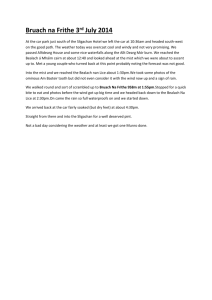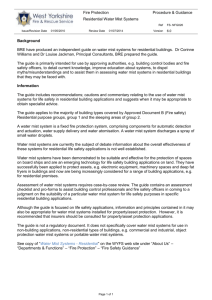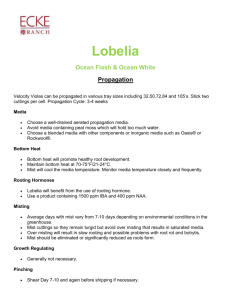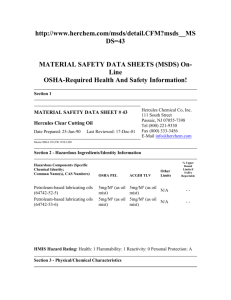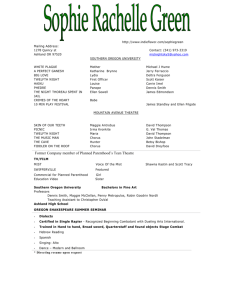Mist Propagation Systems
advertisement
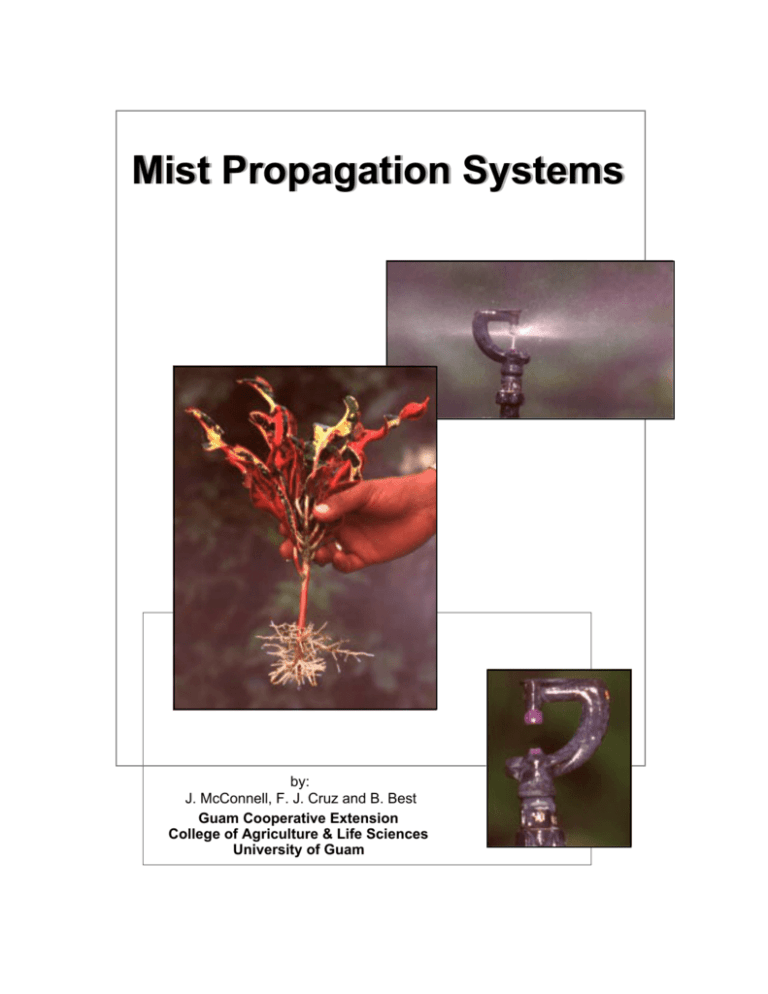
Mist Propagation Systems by: J. McConnell, F. J. Cruz and B. Best Guam Cooperative Extension College of Agriculture & Life Sciences University of Guam Mist Propagation Systems; March, 1996 J. McConnell and F. Cruz are Horticulturists with the College of Agriculture and Life Sciences. B. Best is a Research Associate with the Center for Continuing Education & Outreach Programs. Additional information can be obtained by contacting the Guam Cooperative Extension, College of Agriculture and Life Sciences, University of Guam. Telephone numbers 735-2001/9 or by fax 734-6842. Disclaimer Issued in furtherance of Cooperative Extension Work, Acts of May 8, and June 30, 1914, in cooperation with the United States Department of Agriculture. Jeff D. T. Barcinas, Interim Dean/Director, College of Agriculture and Life Sciences, Guam Cooperative Extension College of Agriculture and Life Sciences, University of Guam, UOG Station, Mangilao, Guam 96923. “The programs of the University of Guam Cooperative Extension are open to all regardless of age, race, color, national origin, religion, sex, or disability.” Reference to product names does not imply approval or recommendation of such product by the University of Guam to the exclusion of others that may be equally suitable. Contents Introduction ................................................................................................................. 1 Use of Intermittent Mist .............................................................................................. 1 Components of a Mist System .................................................................................... 1 Mist Nozzles ........................................................................................................ 1 Line Filter ............................................................................................................ 2 Solenoid and Valve .............................................................................................. 2 Mist Controller .................................................................................................... 2 Electrical System ................................................................................................. 3 Anti-Drip Device ................................................................................................. 3 Line Check Valve................................................................................................. 3 Pressure Gauge .................................................................................................... 3 Fertilizer Injector ................................................................................................. 3 Backflow Preventer ............................................................................................. 6 Water Storage Tank ............................................................................................. 6 Pneumatic Pump Tank ......................................................................................... 6 Planning a System ........................................................................................................ 6 1. Selecting a Site ................................................................................................ 6 2. Identify the Water Source ................................................................................ 7 3. Selecting Mist Nozzles .................................................................................... 8 4. Determining Size of Propagating Bed and Pipe Sizes .................................... 8 5. System Layout ................................................................................................. 9 Preventing Operational Problems .............................................................................. 9 Hardening-Off and Post-Propagation Care ............................................................ 10 APPENDIX A ............................................................................................................. 11 Recommended Number of Nozzles ................................................................... 11 APPENDIX B ............................................................................................................. 12 Solar Powered Systems ..................................................................................... 12 Introduction In cutting propagation, a portion of the stem, root or leaf is first cut from a parent stock plant. Chemical, mechanical and/or environmental manipulation is used to induce cuttings to produce roots and shoots. Cuttings are used to produce plants that are, in most cases, identical to the original plant. Propagation by cuttings is the most important means of propagating ornamental shrubs, florist crops, foliage crops and some fruit species. The ease of propagating by cutting varies with species. An intermittent mist system will, in many cases, speed up the rooting process and allow the rooting of normally difficult-to-root species. This booklet describes how to set up a mist system. Use of Intermittent Mist Intermittent mist systems are used widely to improve the success of rooting softwood, hardwood and herbaceous stem cuttings and leaf cuttings. These systems produce a fine mist that provides a thin film of water over the cuttings and media. The water film controls water loss from cuttings by increasing the humidity and reducing leaf temperature by evaporative cooling. Because of the mist, leafy cuttings can be exposed to high levels of light. This accelerates the rooting and establishment of many difficult to root plant materials. Mist propagation allows for greater flexibility in preparing cuttings. Generally, most types of cuttings will root more readily under mist. Larger cuttings can also be rooted than would be possible without mist. While a mist is used to maintain a film of water on the leaves, it is important to use a minimum amount of water. Excessive water leaches nutrients from the cutting and the rooting medium. The excess water also saturates the growing medium, greatly reducing the amount of air in the medium. As mentioned previously, excess moisture at the bottom of the cutting restricts a good supply of air necessary for rooting. The amount of water can be reduced by using a fine mist nozzle and using intermittent mist. The finer the mist, the less water consumed. The use of intermittent mist is the best solution to prevent overwatering. This requires a controller that switches the water on and off at some interval of time. Components of a Mist System The following are descriptions and functions of various components of a mist system. Mist Nozzles The choice of mist nozzle is based on several considerations: size of desired droplets, amount of water used, mist pattern and maintenance needs. The droplet size should be in the range of 0.002 to 0.004 inch. Small droplet size allows the mist to remain suspended as a cloud for a few seconds before landing on the surface of the cutting. Coarse droplets are not desirable. The goal is to maintain a film of water on the cuttings without saturating the medium. The two common types of nozzles are the pressure jet (Fig. 1) and the anvil nozzle (Fig. 2). In the pressure jet type, water is forced through small angled grooves. The water exits the nozzle as a mist. Water output is 0.25 to 2.0 gallons per minute. The anvil nozzle pro- 1 duces a mist by shooting a stream of water at a flat surface. The anvil nozzle is less prone to clogging, but uses more water. Line Filter It is best to include a filter (Fig. 3) or strainer on the inlet water line to lessen the incidence of clogging of the mist nozzles and solenoid. The type of filter and size of mesh depends on water quality. The filter should precede the solenoid valve in a mist line. For potable water sources, use filters with perforations about half the size of the nozzle opening. With storage tanks and stream water, contamination by algae and other organisms is a problem. A sand or gravel filter may be needed to remove biological impurities. Solenoid and Valve The solenoid (Fig. 4) is an electrically activated switch that operates a valve (Fig. 4) that controls the flow of water through the system. The solenoid is switched on and off by the mist controller. Mist Controller The goal of a mist system is to keep a thin film of water on the leaves without saturating the media. If the mist is continuous, the media often becomes saturated; thereby, reducing the air to the base of the cutting. The loss of air reduces the success of rooting and causes a greater incidence of disease. Continuous misting also washes nutrients out of the cuttings and media. The controller is used to reduce the frequency of misting to the desired interval. There are two basic types of controllers: one type is triggered by a timer, the other type is triggered by a sensing device. A time clock (Fig. 5 & 6) can be set to turn on a solenoid at desired intervals. These controllers easily control the duration of the mist cycle and the interval of time between cycles. Models are also available that allow the cycle to only work during certain hours. This is useful to shut the mist cycle off during the night and on during the daytime. The disadvantage is that the misting interval remains the same regardless of the weather. If the time clock is set to mist for 3 seconds at 5 minute intervals, this may be excessive in cloudy, rainy weather, but inadequate during bright sunny days. In addition, at night the misting interval is always excessive. There are controllers available capable of having different intervals between day and night. The other type of controller uses a sensing element. One of the simpler sensing element controllers is the screen balance (Fig. 7). A sensor is used in conjunction with a solenoid valve. The screen balance is placed among the cuttings. There is a screen on the sensor that becomes covered with a film of water, similar to the leaves of cuttings. At a certain stage of dryness, the switch activates the solenoid producing mist. The weight of water on the screen balance causes the mist to shut off the water valve. The frequency of misting is controlled by a combination of the temperature, humidity and light intensity. On bright days misting may occur every 2 to 3 minutes, but on a cloudy day the interval may be greater than 15 minutes. The mist may only come on several times during the night. The disadvantage to the screen balance sensor is its sensitivity to wind. If the sensor is not protected from wind gusts, the frequency of misting will greatly increase and not be related to moisture loss. 2 Electrical System There are several options in designing the electrical system. Solenoids commonly operate at either 110 volts or 24 volts. A 110 volt system can be hazardous especially since the mist area is constantly wet. The safer approach is to use 24 volt power at the misting site by converting a 110 volt line to 24 volts with a transformer. This at least reduces the chance of electrical shock from the higher voltage. There are also battery-powered systems available. These also operate at low, safe voltages. The danger of electrical shock should always be kept in mind when installing and using an electrical control unit in a mist bed. The complete electrical installation should be done by a competent electrician. One other choice is the use of solar power. A solar powered system has the advantages of not requiring the installation of high voltage wiring and allows remote areas (off the power grid) to operate. Also, the mist system will operate through power outages without interruption. The disadvantage is the additional cost of the solar power components. These include the solar panels, storage batteries, and associated controls and meters. Solar powered systems are discussed in Appendix B. Anti-Drip Device Anti-drip devices can be installed between the mist nozzle and the supply line. The device will prevent dripping from nozzles between misting cycles. These devices operate either by draining the pipe or a valve opens and closes, when the water pressure changes. The type that drains the line is wasteful of water, making the pinch valve type preferred. The pinch valve type maintains water in the line making the misting more efficient since the line does not have to refill during each cycle. Line Check Valve A line check valve can be installed on the supply line to prevent water in the pipe from draining when the controller shuts off. This will minimize the time it takes to pressurize the mist system, increasing the uniformity of distribution. Pressure Gauge A pressure gauge is useful for monitoring the water pressure on the feed line to the mist nozzles. A pressure gauge will help differentiate between mist failure due to low pressure and failure due to clogged nozzles. The general operating pressure range is between 20 and 80 psi. Fertilizer Injector An injector (Fig. 8) has a maintenance role in a mist system. The hardness of the water in Guam results in calcium buildup on the pipes, mist controller (screen balance type) and mist nozzles. Special fertilizers can be injected to reduce the buildup of calcium in the system. Backflow Preventer A backflow preventer (Fig. 9) is a device that isolates the mist system from the main water line by preventing water from returning to the main when pressure is reduced or 3 Mist droplets are expelled out of the center hole. Underside of nozzle Side view Top view Water enters here Water enters side opening and leaves nozzle through center hole. Figure 1. Pressure Jet Nozzle Spreader Water stream exits nozzle and strikes spreader producing droplets Water enters here Water enters here Figure 2. Anvil Type Nozzles 4 Solenoids Figure 3. Line Filter Figure 4. Valves with Solenoids Valves Figure 5. Electronic Controller with Solenoid and Valve Figure 6. Electric Controller Screen moves downward as mist increases the weight Figure 7. Screen balance sensing controller Figure 8. Fertilizer injectors Figure 9. Backflow preventer with valve 5 lost. The installation of a backflow preventer or an equivalent device is required by law when using a fertilizer injector in the system. Water Storage Tank A storage tank can be used to insure that water is available for misting even during water outages such as after a typhoon. Another advantage of a storage tank is that rain water can be collected which will reduce the problem of calcium buildup. Pneumatic Pump Tank When line pressure is too low, due to using a storage tank or due to poor water pressure in the supply line, a pneumatic pump tank needs to be installed. With the addition of a pneumatic pump tank the mist system can be operated in locations without public utilities. In addition, the system can be functional after major storms when power and running water are not normally available. If a pneumatic pump tank is added to your mist system, a backflow preventer needs to be added to the main water line, before the tank. The backflow preventer will stop the draining of the tank if there is a water outage. Planning a System The five steps in planning a mist system are: 1) Selecting a site 2) Identify a water source 3) Select mist nozzles 4) Select bench and pipe size 5) System layout 1. Selecting a Site The three primary considerations in choosing a site for a mist propagation unit are: 1) Exposure to sunlight. 2) Exposure to wind 3) Drainage Select a site that will receive at least 6 hours of direct sun throughout the year. There should be no obstructions blocking the sun during the day. Systems located too close to buildings may be partially shaded during parts of the year. Remember, shade can always be added at little cost, while supplemental lighting is expensive. Mist propagating units must be protected from the wind. Even wind speeds as low as a few miles per hour will blow the mist off target resulting in poor or failed rooting. When using a screen balance sensor, wind can activate the mist more often than is required. The excessive water will cause the rooting medium to become too wet and cause the bottoms of the cuttings to rot. Screen movement can also shut the solenoid off prematurely. Good drainage in and around the misting unit will decrease the chance of disease and will increase safety in the mist area by decreasing the incidence of puddles. Keeping the area free of standing water will lessen the growth of algae. If algae grow in the misting 6 area, the growing medium can become contaminated with algae. Algae will compete for nutrients with the rooting cuttings. 2. Identify the Water Source If potable water is to be used on the site, three numbers must be gathered. The first number is the service pipe size at the site. Second is the flow rate in gallons per minute (gpm) and the third is the static water pressure. Typical service pipe sizes for households are 1/2" and 3/4". The service pipe size can be estimated by measuring the circumference of the pipe using a piece of string. Wrap a piece of string around the pipe one time and then measure the string length. A string length of approximately 2 5/8" would indicate a 1/2" service line and a string length of 3 1/2" would be a 3/4" service line. The rate of water flowing through the line can be determined in two ways. Fully open a water valve closest to the planned mist site. While the water is flowing, read the change in gallons from the meter for a one minute period. Another method requires catching the water from the fully open service line in a container of known capacity (e.g., 5 gallon bucket). Record the time in seconds it takes to fill the container with water. To convert units, cross-multiply with the equivalence of one. The static (no movement) water pressure in pounds per square inch (psi) can be determined by attaching a water pressure gauge to the end of the service line and reading the pressure from the gauge. The water pressure and flow rate should be determined several different times to determine potential low periods. The lowest values should be used in planning a system to prevent failure during times of low pressure. Frequent low pressures may indicate the need for a pump. Most mist nozzles require pressures of 20 psi or more to operate properly. Consult a qualified professional if static pressure is inadequate. Look in the Yellow Pages of the telephone book under “Plumbing” for assistance. When potable water is not available, rain water can be stored and pressurized as mentioned earlier. 3 example: Water from a 4" pipe takes 30 seconds to fill a bucket to the 5 gallon mark. 2 5 gal 60 sec 5 gal 60 sec 1 min 1 min 30 sec 30 sec 5 gal 1 2 1 min 10 gal min The flow rate is 10 gpm. 3. Selecting Mist Nozzles 7 It is important to choose mist nozzles that operate within the working pressure at the site. To ensure proper operation and to accommodate differences in valve types and options, one should choose mist nozzles with working pressures within about 70% of the static water pressure at the site. The nozzles with lower flow rates also generally produce the desired finer mist needed for propagation. Nozzles with high flow rates can overwater the cuttings resulting in leaching of nutrients and reducing the chance of successful rooting. 4. Determining Size of Propagating Bed and Pipe Sizes Mist nozzles that produce the fine mist needed in mist propagation systems are generally spaced between 3' and 5' apart. This spacing produces coverage ranging between 3' to more than 8' in diameter. Typically, propagating beds are from 3' to 4' wide to allow for easy access. Commonly, flats are placed under the mist with cuttings stuck in a propagating medium. The flats must be within easy reach of the individual sticking the cuttings. The length of the beds is limited by the flow and pressure at the site and by the pipe size. Total flow rates through all the nozzles should only take up about 70% of the flow rate measured at the site. The maximum number of nozzles for 1/2" and 3/4" pipes are listed in Appendix A. At the corresponding flow rates, the friction loss and velocity of the water in the pipes will be within pipe manufacturers’ recommended limits. When flow rates or line lengths exceed those listed, multiple lines with independent controllers can be utilized. If this 70% guideline for either the flow or pressure requirements cannot be met, one should consult with professionals. 5. System Layout Two representative systems are shown in Figures 10 and 11. The Figures show the locations of the basic parts of a mist system. Figure 10 shows a system in which the misting Mist Nozzles Timer, Solenoid & Valve Water Supply Line Filter Figure 10. A mist system with a timer. The mist will turn on as programmed in the timer. 8 interval is controlled by a timer. The system shown is battery powered. If the timer requires 110 volts, a surge suppressor is recommended to isolate the system from electrical damage. Figure 11 shows a system that uses a screen balance sensor to control the mist. The sensor is placed on the bench. The sensor will be misted along with the cuttings. The frequency of misting should be monitored and adjusted as needed. Some form of wind protection is required to prevent the mist from drifting off the bench and missing the cuttings and the sensor. Wind protection is particularly important to have when using the screen balance sensor. Preventing Operational Problems There are some difficulties that may arise in the operation of a mist system. Low water pressure is a common problem. Many operators prefer to operate with a minimum mist line water pressure of 50 psi. This pressure ensures that a mist and not a drizzle is produced. Follow the recommended pressure for a particular mist nozzle. Following the recommended pressure insures uniform coverage is maintained with the proper spacing of the nozzles. The best way to correct low pressure is to install the pneumatic pump tank described above. Calcium deposits will build up on the mist lines and the nozzles when Guam’s municipal water is used. Either an injector can be used to inject a mild acid (vinegar) into the Electric Power Mist Nozzles Screen Balance Controller Wire from Controller to Solenoid Manual Valve Solenoid Water Filter Pipline to Water Supply Stakes supporting Nozzles Main Water Line (Black Poly Hose) Water Line to Mist Nozzle (Black Poly Tubing) Figure 11. A mist system regulated by a screen balance controller. The solenoid will turn on the mist when the moisture evaporates from the screen. Note that the screen balance controller is inside the area misted by the nozzles. In an actual system the controller needs wind protection 9 system, or a rain catchment system can be used. One disadvantage to rainwater is that algal growth can be a problem. Chlorinated water reduces the incidence of algae. Line filters and mist nozzles should be checked and cleaned periodically. Proper maintenance will lessen the chance of having problems with clogged nozzles or solenoids. The screen balance sensor should be cleaned weekly with a toothbrush and vinegar to keep it clean of calcium deposits. If the screen is not kept clean, the performance of the controller will be affected requiring the counterbalance weight to be adjusted to maintain the desired frequency of misting. Hardening-Off and Post-Propagation Care Hardening-off is the process of gradually removing the rooted cuttings from the mist environment. It is best to reduce misting once the cuttings root, and allow secondary root development out of the mist. The weaning process forces the rooted cutting to become more self-sufficient in absorbing nutrients and water through the newly formed root system. Hardening-off conditions the leaves and stems to tolerate the stresses of lower humidity, higher light intensity and higher temperatures outside of the mist system. Cuttings deteriorate if they are left in the mist too long after they have rooted. This reduces the root quality, causes premature leaf drop and slows down growth. The deterioration reduces the quality of the finished cutting. It is a good idea to not mix different species in the same flat. One species may be ready to be hardened off while another may not have rooted. If the cuttings are in the same flat, they will need to be disturbed and replanted. Hardening-off encourages more efficient secondary roots to develop from rooted cuttings. There are several ways to successfully harden rooted cuttings: 1. The cuttings may be left in place and the duration of the misting periods gradually decreased either by lessening the “on” times or increasing the “off” times or by leaving the misting intervals the same, but gradually decreasing the time for which the mist is in operation each day. 2. Root the cuttings in flats and move the flats after rooting to another mist where they are hardened off and then potted into containers. 3. Some propagators directly stick the cuttings in small containers set in flats. After rooting, the plants are easily moved for transplanting without disturbing the roots and adjacent cuttings. There are also types of solid block rooting media. The larger pieces of material will have a small block for each cutting. The individual rooted cuttings can be separated for transplanting. These blocks are made of compressed peat, wood products or synthetic materials. 4. Pot the cuttings after they root and place them in a cool, humid, shaded location until they are hardened. 10 APPENDIX A Recommended Number of Nozzles 1/2" pipe with 3gpm water flow rate Nozzles with a flow rate of 0.125 gpm Nozzles with a flow rate of 0.25 gpm Nozzles with a flow rate of 0.50 gpm Nozzles with a flow rate of 0.75 gpm Max. no. of nozzles on at one time 24 12 6 4 Max. pipe length @ 3' spacing 72' 36' 18' 12' Max. pipe length @ 4' spacing 96' 48' 24' 16' 3/4" pipe with 6gpm water flow rate Nozzles with a flow rate of 0.125 gpm Nozzles with a flow rate of 0.25 gpm Nozzles with a flow rate of 0.50 gpm Nozzles with a flow rate of 0.75 gpm Max. no. of nozzles on at one time 48 24 12 8 Max. pipe length @ 3' spacing 144' 72' 36' 24' Max. pipe length @ 4' spacing 192' 96' 48' 32' Table 1. Maximum recommended number of nozzles at four different flow rates and appropriate pipe lengths at 3' & 4' spacing for 1//2" and 3/4" lines. 11 APPENDIX B Solar Powered Systems The basic wiring of two photovoltaic (PV) charging systems are shown in Figures 12 and 13. Figure 12 shows a very basic system that will power a mist system. The following are some guidelines for constructing a solar powered system. A minimum of ten gauge multi-stranded wire is recommended for wiring a solar powered system. Make sure that all connections are made securely and sealed to prevent loose connections. For the Northern Pacific region, solar panels should be mounted slightly elevated and facing south. Care should be taken to position the solar panels so that they are exposed to sunlight throughout the day. Slight shading through the day greatly decreases the charging efficiency. The voltage meter is included in the basic system to monitor the battery system. The system should be inspected if the voltage drops below 24 volts. A diode is installed to prevent the flow of electrons from the batteries to the PV module. The diode is basically a back-flow preventer for electricity stored in the batteries. Figure 13 shows a system that has additional control circuitry that allows the system to be maintained more easily. The heart of the Controller/Load Center is an epoxy filled wallmounted charge controller. It includes overcharge protection and the diode. The unit also makes it easier to connect the wires. The amperage meter will show whether the solar panels are charging the batteries. By having the combination of the volt meter and the amp meter, you can more easily diagnose the main problems that are: 1) loose wires; 2) solar panels not working efficiently; 3) worn batteries; 4) excess use of electricity. If during the daylight hours the amp meter does not show a reading around 500 mA then the solar panels are not working or a wire is loose between the panels and the batteries. If the panels are charging (500 mA reading on amp meter), but the batteries are low, the system is using power faster than the panels can charge the batteries. The excessive use of electricity may be due to wind moving the sensor. The Battery Saver is a combination alarm and safety switch for the batteries. If the voltage drops below 23.5 volts, an alarm will go off to warn that the charge in the batteries is being used faster than it can be recharged. This will tell you of a potential problem at an early stage. At 23 volts, the Battery Saver will shut down the system so that the batteries are not damaged. The optional components are especially useful if employees that are unfamiliar with the mist system will be working in the nursery or if the system would be left unattended for extended periods. The alarm and the meters will help to identify a problem at an early stage. It is important to keep the system maintained so that cuttings are not lost due to a mist system malfunction. 12 12 Volt DCPV 12 Volt DCPV Diode Voltage Meter 24 Volt Connection to Sensor 12 V DC Battery Figure 12. Wiring diagram for a basic photovoltaic charging system. 12 Volt DCPV A+ B+ 12 Volt DCPV L+ L- B- A- 24 volt controller/load center Battery Saver B- L+ B+ L- 24 Volt Connection to Sensor 12 V DC Battery Figure 13. Wiring diagram for a photovoltaic charging system with recommended options. 13
